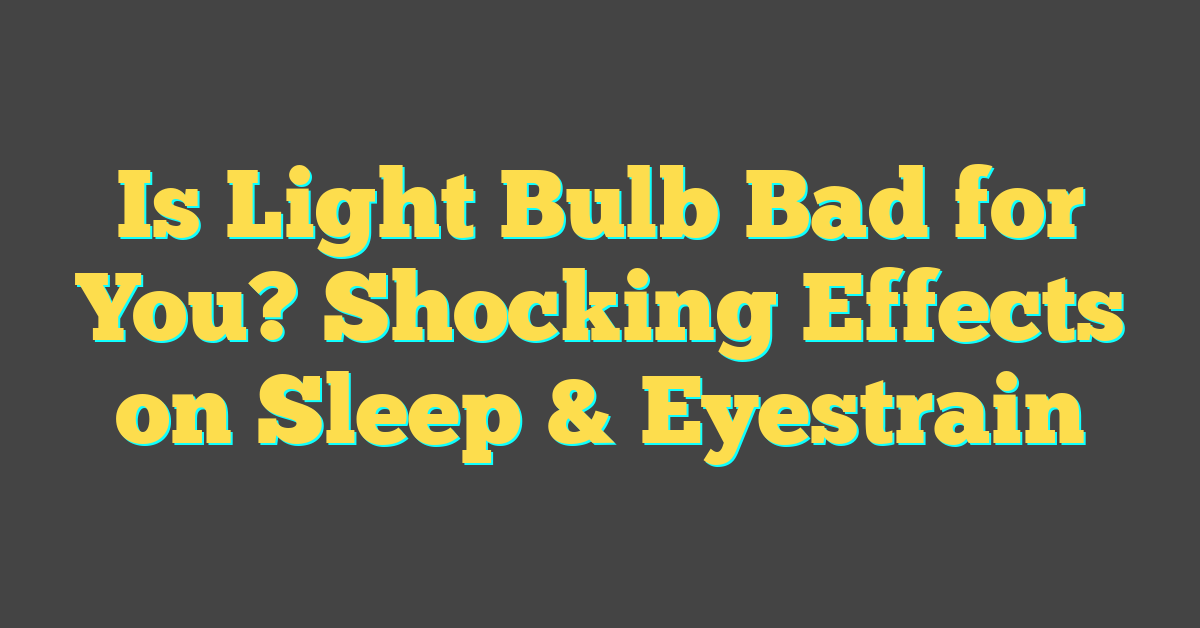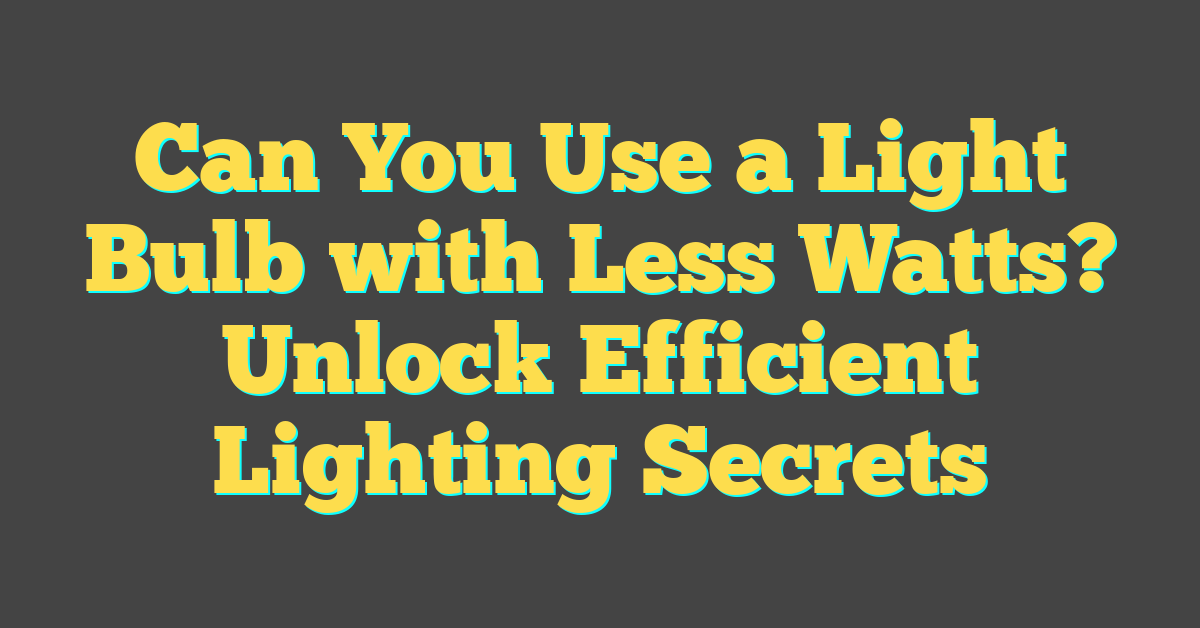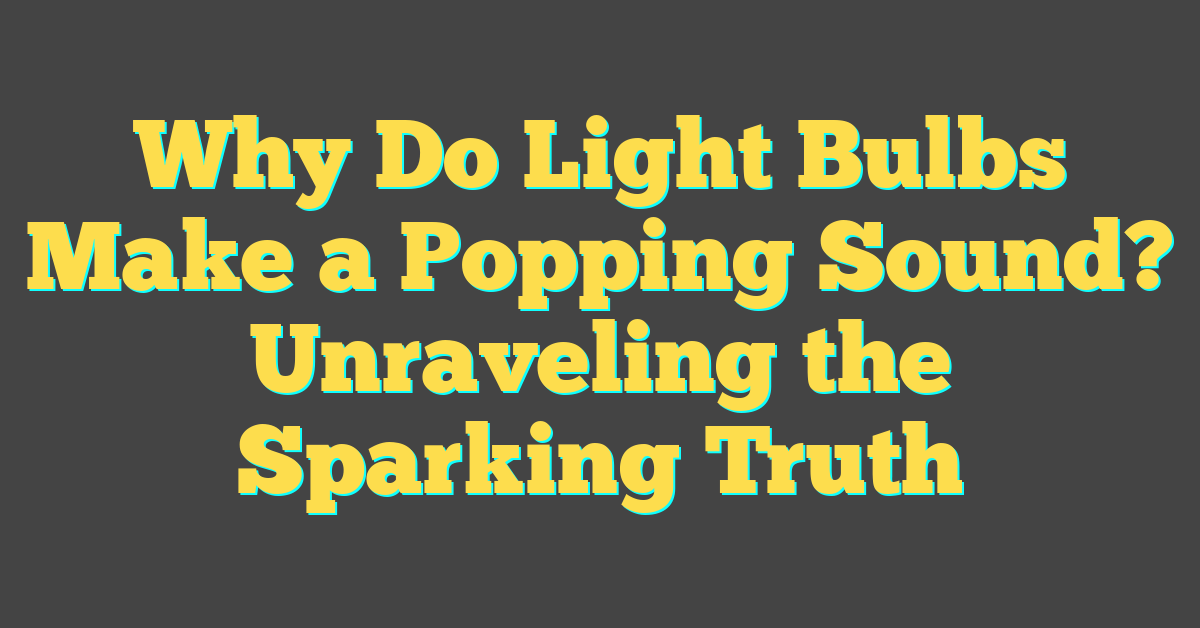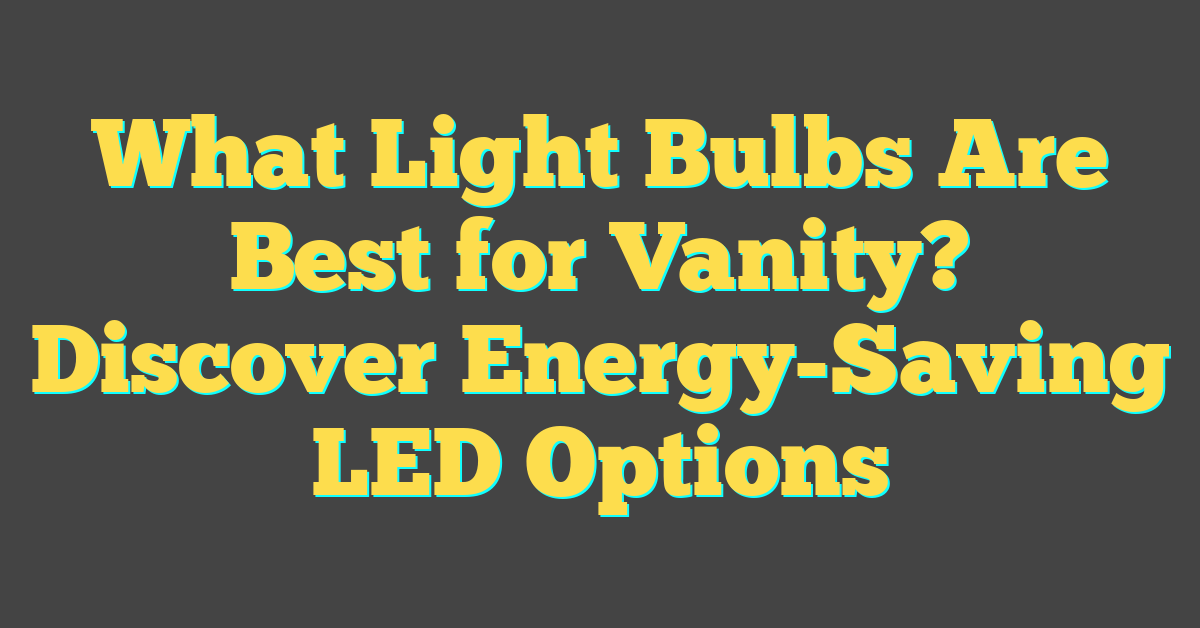Ever wondered if those glowing bulbs overhead could be doing you more harm than good? You’re not alone. With the world lit up 24/7, it’s smart to question what that constant exposure to artificial light is doing to your health.

Sure, light bulbs are the unsung heroes of our modern lives, but there’s a buzz about potential downsides that’s hard to ignore. From sleep disruption to eye strain, it’s time to shed some light on the subject and find out if it’s just a flicker of concern or something to really watch out for.
Stick around as we delve into the science behind light bulbs and health. You’ll discover how these everyday items might impact you more than you think.
The Impact of Artificial Light on Health
As a lighting aficionado, you’re always looking to create the perfect ambiance. But beyond setting the mood, it’s essential to consider how artificial light, the trusty glow from light bulbs that illuminates your late-night DIY projects, affects your health.
Blue Light and Your Sleep Cycle take center stage when you’re up at midnight finishing a handcrafted bookshelf. Here’s the scoop: blue light, largely emitted by LED bulbs, can mess with your circadian rhythm. This is your body’s natural sleep-wake cycle. Exposure to excessive blue light after sunset tricks your brain into thinking it’s still daytime, potentially leading to sleep disorders.
The table below highlights a brief comparison of various light bulb types and their blue light emission:
| Light Bulb Type | Blue Light Emission | Warmth of Light |
|---|---|---|
| Incandescent | Low | Warm |
| CFL | Medium | Cooler |
| LED | High | Varies (Cool to Warm) |
Eye Strain and Discomfort are familiar foes, especially when you’re pouring over the minute details of your latest creation. Prolonged exposure to bright artificial light from light bulbs could lead to digital eye strain, characterized by symptoms like dry eyes, headaches, and blurred vision.
Take note of Flicker and Glare; while often imperceptible, flickering from fluorescent lights can lead to eye fatigue and discomfort. Similarly, glare from overly bright bulbs can create harsh working conditions and even exacerbate migraine symptoms in sensitive individuals.
In your quest for the ideal lighting, keep these considerations in mind. You might favor the efficiency of an LED bulb, but pairing it with a dimmer switch or opting for warmer color temperatures in the evenings could safeguard your health. On those nights when you’re tinkering away, think of the balance between functionality and wellbeing and choose your light sources wisely.
Understanding Light Bulbs: Types and Technologies

When you’re picking out light bulbs, you’re not just choosing how to light your room. You’re deciding on the quality and comfort of your space, and believe it, the type of bulb you choose plays a massive role. There’s a variety of light bulbs out there, each with its own tech and purpose.
Incandescent bulbs, those classic bulbs with the warm glow, have been illuminating homes for over a century. They’re the old school choice and provide a comforting ambiance reminiscent of a cozy, well-lived space. But they’re not the most energy-efficient kids on the block.
Enter CFLs (Compact Fluorescent Lamps), which are a departure from the incandescents with their curly design. They rock because they use about 70% less energy and have a longer lifespan. DIY enthusiasts might remember the first time they swapped out an old bulb for a CFL, feeling like a pro saving energy and money.
LEDs (Light Emitting Diodes) are the newer contenders in the game. They’re champs in energy efficiency and lifespan, running circles around incandescents and CFLs. If you’re thinking long-term investment and sustainability, LEDs are your go-to. Plus, they come in a rainbow of colors for those innovative DIY lighting projects that make a room pop.
Here’s a quick rundown of the pros and cons:
| Bulb Type | Pros | Cons |
|---|---|---|
| Incandescent | Warm glow, Instant brightness | Short lifespan, High energy consumption |
| CFLs | Energy saving, Long lifespan | Slow to light up, Contains mercury |
| LEDs | Best energy efficiency, Super long lifespan | Higher upfront cost, Sensitive to high temperatures |
« Can Light Bulbs Cause a Fire? Surprising Safety Facts You Need to Know
Why Is Tungsten Good for Light Bulbs? Uncover the Glow Secret »
Brighten up, and you’ll find that smart bulbs and WiFi enabled lights have joined the party too. They bring a whole new level of control and interactivity, ensuring that your lighting can be as smart as the rest of your tech-savvy home.
Remember to consider the bulb’s color temperature—you’ll want warmer tones for relaxation and cooler ones for concentration areas. And don’t forget about dimmable options; they’re the secret ingredient to dialing in that perfect mood lighting for any occasion.
Blue Light and its Effect on Sleep

When night falls and natural light fades, your home lighting takes center stage. But not all light affects your body the same way, especially when it comes to sleep. Blue light, emitted in large amounts by LEDs and electronic screens, has a unique effect on your circadian rhythm.
This short-wavelength light is highly efficient during the daytime, keeping you alert and focused. However, as darkness approaches, your body expects a reduction in blue light, signaling that it’s time to wind down. Exposure to blue light in the evening tricks your brain into thinking it’s still daytime, potentially delaying the release of melatonin, the sleep hormone. This disruption can lead to difficulties in falling asleep and may diminish the quality of your slumber.
Research backs this up. A study published in the Journal of Clinical Endocrinology & Metabolism found that participants exposed to blue light had delayed melatonin onset, leading to less restorative sleep. Consider integrating the following habits to mitigate blue light’s effect on sleep:
- Avoid screens at least an hour before bed, giving your body a break from intense blue light.
- Swap out bright, blue-light-emitting bulbs in your bedroom with warmer tones that mimic the sunset.
- If you’re a night owl using devices late, enable night mode or use blue light filters to lower the intensity.
For those DIY enthusiasts who love tailoring every bit of their home environment, installing smart bulbs with adjustable color temperatures can be a game-changer. You’ll enjoy the ability to switch from energizing daylight tones to calming warm light with just a tap on your phone or a scheduled automation.
Remember, every detail in your lighting design impacts your comfort and well-being. So next time you’re swapping out a bulb or choosing a fixture, think about how that light will interact with your natural body rhythm. Your sleep quality might just thank you for that extra consideration.
Eye Strain and Visual Discomfort from Light Bulbs

As you dive deeper into the nuanced world of lighting, it’s crucial to address another common concern: eye strain and visual discomfort stemming from light bulbs. If you’ve ever felt that nagging headache or soreness in your eyes after a long day, your lighting could be the culprit.
Intensity and brightness play pivotal roles in how our eyes perceive light, and overexposure to harsh lighting conditions can lead to symptoms commonly associated with eye strain. Imagine spending hours under the aggressive glow of a high-wattage bulb; it’s similar to the exhaustion your eyes would feel after staring at a sunlit snowscape.
- Opt for bulbs with dimmable features.
- Use shades or diffusers to soften the light.
Flickering lights, often unnoticed, also contribute significantly to discomfort. You might not see the rapid on-off cycles of an LED, but your eyes are sensitive to these micro-movements, which can lead to eye fatigue. To prevent this invisible strain:
- Ensure your bulbs are compatible with your dimmers.
- Replace any flickering bulbs promptly.
Color temperature is another aspect that heavily influences visual comfort. Bulbs emitting cooler tones akin to daylight can be beneficial for concentration and alertness during the day. However, these tones can be jarring at night or when relaxation is the goal.
- Warm light bulbs are preferable for evening use.
- Balance task lighting with ambient lighting to avoid harsh contrasts.
Reflecting on your home’s current lighting setup and making small but impactful changes can greatly reduce eye strain and enhance overall comfort. Remember, every bulb in your home affects not only the ambience but also your visual health. So next time you’re involved in a home DIY project, consider how the lighting will play a part in your room’s functionality and your visual well-being.
Minimizing the Negative Effects of Light Bulbs

You might be wondering how you can reduce the adverse effects of light bulbs on your health without having to live in the dark. As a passionate DIYer and lighting enthusiast, you’ve got several tricks up your sleeve to create a healthy illumination setup in your home.
Firstly, adjusting color temperatures according to the time of day can work wonders. Stock up on a range of bulbs with different color temperatures for various rooms and activities. During the day, cooler, bluer light mimics the midday sun and enhances focus and alertness. Once the evening rolls around, switch to warmer, lower Kelvin bulbs to promote relaxation and prepare your body for sleep. If you’re into tech-savvy solutions, installing smart bulbs can make this transition seamless with programmable settings right from your smartphone.
Besides color, it’s important to pay attention to the intensity of the light. Using dimmer switches can adjust brightness to suit your comfort level. If you love a bit of mood lighting, this is perfect for setting a cozy atmosphere while reducing the potential for eye strain.
Here are a few more tips to further safeguard your visual and circadian health:
- Position lighting fixtures to minimize glare and harsh shadows, especially in workspaces.
- Incorporate natural light whenever possible; well-placed mirrors can amplify daylight.
- Use task lighting to keep bright light focused where you need it, reducing the need for overall high wattage in the room.
Remember, it’s not just about choosing the right bulb; it’s also about how you use it. The twin goals of ambiance and visual health can both be met with a touch of creativity and the right fixtures. Embrace layers of light by combining overhead lights with floor lamps, desk lamps, and wall sconces. This approach minimizes the contrast between light and dark areas in a room, helping your eyes adjust easily and reducing strain.
Your efforts will pay off with a lighting environment that’s both aesthetically pleasing and aligned with your well-being. Now let’s light up your world in a way that’s beneficial to you and everyone who steps into your illuminated haven.
Conclusion
You’ve seen how the light bulbs around you can affect more than just your room’s brightness. It’s clear that the blue light from LEDs can mess with your sleep and too much artificial light might strain your eyes. But don’t worry! You’ve got this. By tweaking your lighting setup and making small changes like using warmer bulbs at night and dimming lights where you can, you’ll protect your sleep and your eyes. Remember to balance your light sources and embrace natural light whenever possible. With these adjustments, you’ll create a space that’s not only comfortable and inviting but also healthier for you. Sweet dreams and happy, healthy living to you!
Frequently Asked Questions
What effects does blue light have on sleep?
Blue light from LEDs and electronic screens can delay the release of melatonin, the sleep hormone, disrupting our circadian rhythm and potentially leading to difficulties in falling asleep and poor sleep quality.
How can one minimize the impact of blue light on sleep?
It’s recommended to avoid screen usage at least an hour before bed, use warm-toned bulbs in the bedroom, and employ night mode or blue light filters on devices. Smart bulbs with adjustable color temperatures can also help control exposure to blue light.
What are the causes of eye strain from light bulbs?
Eye strain can be caused by the intensity and brightness of light, flickering bulbs, and inappropriate color temperature. Harsh contrasts between task lighting and ambient lighting can also contribute to visual discomfort.
How can you reduce eye strain caused by lighting?
To reduce eye strain, use dimmable bulbs, apply shades or diffusers, ensure compatibility of bulbs with dimmers, replace flickering bulbs, and choose warm light bulbs for evening use. Balancing task lighting with ambient lighting can also help.
What tips are suggested for minimizing negative effects of light bulbs?
The article suggests adjusting color temperatures, using dimmer switches to control brightness, strategically positioning fixtures to reduce glare, incorporating natural light into your space, and using task lighting to create layers of light for visual comfort and ambient effect.




